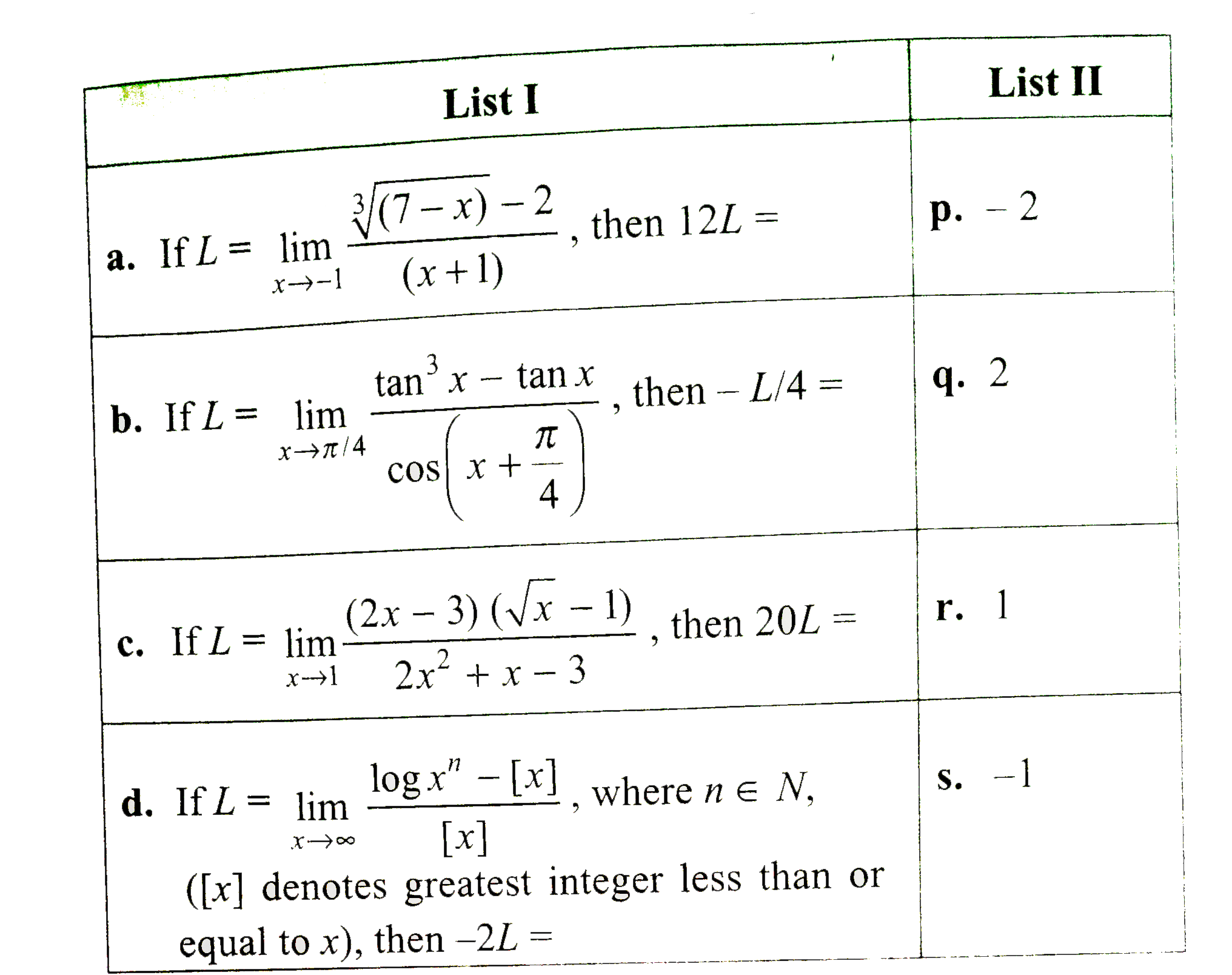Let f''(x) be continuous at x=0
If limx→02f(x)−3af(2x)+bf(8x)sin2x exists and f(0)≠0,f'(0)≠0, then the value of 3a/b is________.
The correct Answer is:(7)
To solve the problem step-by-step, we will analyze the limit given in the question and derive the necessary equations to find the value of 3ab.
Step 1: Understanding the Limit
We need to evaluate the limit:
limx→02f(x)−3af(2x)+bf(8x)sin2x
Given that f(0)≠0 and f′(0)≠0, we know that both the numerator and denominator approach 0 as x→0.
Step 2: Applying L'Hôpital's Rule
Since both the numerator and denominator approach 0, we can apply L'Hôpital's Rule. We differentiate the numerator and denominator.
- The derivative of the numerator:
ddx(2f(x)−3af(2x)+bf(8x))=2f′(x)−3a⋅2f′(2x)+b⋅8f′(8x)
This simplifies to:
2f′(x)−6af′(2x)+8bf′(8x)
- The derivative of the denominator:
ddx(sin2x)=2sinxcosx=sin(2x)
Step 3: Evaluating the Limit Again
Now we need to evaluate:
limx→02f′(x)−6af′(2x)+8bf′(8x)sin(2x)
As x→0, f′(x) approaches f′(0), and similarly for f′(2x) and f′(8x).
Step 4: Substituting Values
Substituting x=0:
2f′(0)−6af′(0)+8bf′(0)0
This implies that the numerator must also approach 0 for the limit to exist:
2f′(0)−6af′(0)+8bf′(0)=0
Factoring out f′(0) (since f′(0)≠0):
f′(0)(2−6a+8b)=0
Thus, we have:
2−6a+8b=0(1)
Step 5: Finding Another Equation
Returning to the original limit, we can also analyze the first limit we derived:
limx→02f(0)−3af(0)+bf(0)0=0
Factoring out f(0):
f(0)(2−3a+b)=0
Since f(0)≠0:
2−3a+b=0(2)
Step 6: Solving the System of Equations
Now we have two equations:
1. 2−6a+8b=0
2. 2−3a+b=0
From equation (2):
b=3a−2
Substituting b into equation (1):
2−6a+8(3a−2)=0
Expanding:
2−6a+24a−16=0
Combining like terms:
18a−14=0⟹18a=14⟹a=1418=79
Now substituting a back to find b:
b=3(79)−2=219−189=39=13
Step 7: Finding 3ab
Now we calculate:
3ab=3⋅7913=21913=219⋅3=213=7
Final Answer
Thus, the value of 3ab is:
7
We need to evaluate the limit:
limx→02f(x)−3af(2x)+bf(8x)sin2x
Given that f(0)≠0 and f′(0)≠0, we know that both the numerator and denominator approach 0 as x→0.
Since both the numerator and denominator approach 0, we can apply L'Hôpital's Rule. We differentiate the numerator and denominator.
ddx(2f(x)−3af(2x)+bf(8x))=2f′(x)−3a⋅2f′(2x)+b⋅8f′(8x)
This simplifies to:
2f′(x)−6af′(2x)+8bf′(8x)
ddx(sin2x)=2sinxcosx=sin(2x)
Now we need to evaluate:
limx→02f′(x)−6af′(2x)+8bf′(8x)sin(2x)
As x→0, f′(x) approaches f′(0), and similarly for f′(2x) and f′(8x).
Substituting x=0:
2f′(0)−6af′(0)+8bf′(0)0
This implies that the numerator must also approach 0 for the limit to exist:
2f′(0)−6af′(0)+8bf′(0)=0
Factoring out f′(0) (since f′(0)≠0):
f′(0)(2−6a+8b)=0
Thus, we have:
2−6a+8b=0(1)
Returning to the original limit, we can also analyze the first limit we derived:
limx→02f(0)−3af(0)+bf(0)0=0
Factoring out f(0):
f(0)(2−3a+b)=0
Since f(0)≠0:
2−3a+b=0(2)
Now we have two equations:
1. 2−6a+8b=0
2. 2−3a+b=0
b=3a−2
Substituting b into equation (1):
2−6a+8(3a−2)=0
Expanding:
2−6a+24a−16=0
Combining like terms:
18a−14=0⟹18a=14⟹a=1418=79
b=3(79)−2=219−189=39=13
Now we calculate:
3ab=3⋅7913=21913=219⋅3=213=7
Thus, the value of 3ab is:
7
Topper's Solved these Questions
- LIMITSBook:CENGAGE ENGLISHChapter:LIMITSExercise:Archives JEE MAIN
Explore 8 Videos
- LIMITSBook:CENGAGE ENGLISHChapter:LIMITSExercise:Archives JEE ADVANCED
Explore 2 Videos
- LIMITSBook:CENGAGE ENGLISHChapter:LIMITSExercise:Matrix Match Type
Explore 5 Videos
- JEE 2019Book:CENGAGE ENGLISHChapter:JEE 2019Exercise:Chapter 10
Explore 9 Videos
- LINEAR COMBINATION OF VECTORS, DEPENDENT AND INDEPENDENT VECTORSBook:CENGAGE ENGLISHChapter:LINEAR COMBINATION OF VECTORS, DEPENDENT AND INDEPENDENT VECTORSExercise:DPP 1.2
Explore 10 Videos
Similar Questions
Let f:R→R be a positive, increasing function with
limx→∞f(3x)f(x)=1. Then limx→∞f(2x)f(x) is equal to
View SolutionIf limx→0[1+xln(1+b2)]1/x=2bsin2θ,b>0, and θ∈(−π,π], then the value of θ is
View SolutionMatch the following lists:

View SolutionIf y = y(x) is the solution of the differential equation, xdydx+2y=x2 satisfying y(1) = 1, then y(12) is equal to
View SolutionThe number of integral values of p for which (p+1)ˆi−3ˆj+pˆk,pˆi+(p+1)ˆj−3ˆk and −3ˆi+pˆj+(p+1)ˆk are linearly dependent vectors is q
View SolutionLet fx be continuous at x=0 If (lim)x→0(2f(x)−3af(2x)+bf(8x)sin2x exists and f(0)≠0,f′(0)≠0, then the value of 3ab is____
View Solutionयदि
f(x)={sin2xsin3x,x≠02,x=0
सिद्ध कीजिये कि फलन f(x), बिंदु x=0 पर सतत नहीं है |
View SolutionLet f(x)={sinπx5x,x≠0k,x=0 if f(x) is continuous at x = 0, then k is equal to
View Solutionयदि f(x)=⎧⎨⎩e1/x1+e1/x,x≠00,x=0 तब limx→0f(x) का अस्तित्व ज्ञात कीजिए।
View Solutionयदि f एक फलां इस प्रकार है कि f(−x)=−f(x) तथा limx→0f(x) का अस्तित्व है तब सिद्ध कीजिए कि limx→0f(x)=0
View Solutionlimx→0f(x) के मान ज्ञात कीजिए , जहाँ
(i) f(x)={|x|xx≠00x=0 (ii) f(x)={x|x|x≠00x=0
View SolutionLet f(x)⎧⎨⎩sin5xx2+2x,whenx≠0k+12,whenx=0 if limx→0f(x)=f(0), then the value of k is-
View SolutionEvaluate limx→0f(x), where f(x)={|x|x,x≠00,x=0
View SolutionEvaluate limx→0f(x), where f(x)={|x|x,x≠00,x=0
View SolutionEvaluate limx→0f(x), where f(x)={|x|x,x≠00,x=0
View Solution
